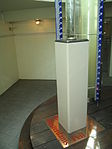Madame Tussauds Amsterdam
1970 establishments in the NetherlandsDam SquareMadame TussaudsMuseums established in 1970Museums in Amsterdam ... and 1 more
Rijksmonuments in Amsterdam

Madame Tussauds Amsterdam is a wax museum situated in Amsterdam, the capital city of the Netherlands. It is located in the centre of the city on Dam Square, near the Royal Palace of Amsterdam. Founded in 1970, it was the first Madame Tussauds that was opened in mainland Europe as well as being the first foreign branch of the British institution. The collection of Madame Tussauds Amsterdam consists of a collection of wax figures of famous celebrities in different categories such as the Golden Age of Dutch history, music, sport and film.
Excerpt from the Wikipedia article Madame Tussauds Amsterdam (License: CC BY-SA 3.0, Authors, Images).Madame Tussauds Amsterdam
Dam, Amsterdam Centrum
Geographical coordinates (GPS) Address Website External links Nearby Places Show on map
Geographical coordinates (GPS)
| Latitude | Longitude |
|---|---|
| N 52.3725 ° | E 4.8925 ° |
Address
Madame Tussauds Amsterdam (Madame Tussauds Amsterdam)
Dam 20
1012 LP Amsterdam, Centrum
North Holland, Netherlands
Open on Google Maps








